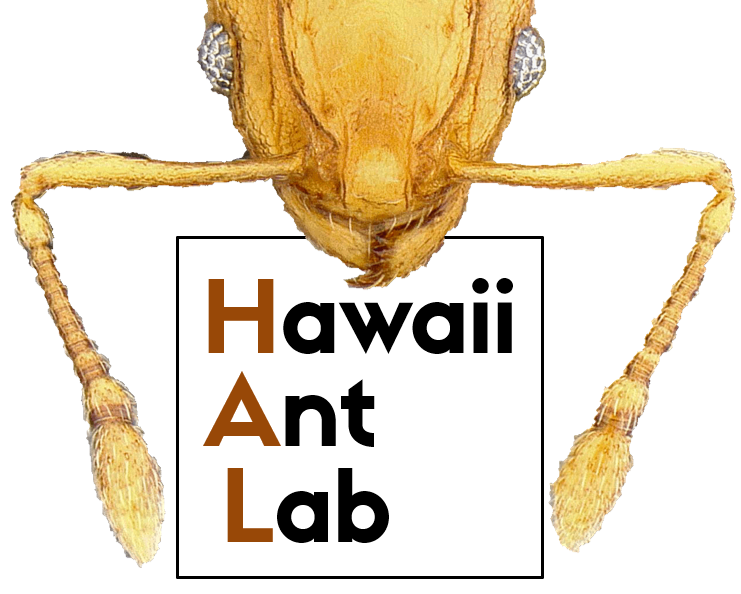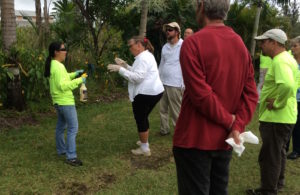Resources for Battling Little Fire Ants on Hawai‘i Island
Hawai‘i Ant Lab
The Hawai‘i Ant Lab (HAL), a program of the UH Pacific Cooperative Studies Unit, is a lab based in Hilo, Hawaiʻi with two other locations in Kailua-Kona and Oʻahu. HAL works with residents, farmers, and nurseries to spread knowledge on prevention and treatment methods for Little Fire Ants (LFA).
We offer the following FREE services:
- Ant identification. You may mail or bring in your ant samples to any of our offices.
- Personalized LFA treatment plans specific to your property.
- Site visits for farmers, nurseries, or other agricultural industries to create a customized treatment plan.
- Ant Management Clinics. Once a month, Hawaiʻi Ant Lab conducts a 1.5 hr long online clinic through Zoom on the last Thursday of every month. This workshop covers everything you want to know about managing Little Fire Ants around your home. Sign up here.
If you are interested in any of our services, contact us at:
Hawai‘i Ant Lab
University of Hawai‘i
875 Komohana St.
Hilo, Hawai‘i 96720
(808) 315-5656
[email protected]
For more information visit: www.littlefireants.com

Big Island Invasive Species Committee
Community Assistance & Training

BIISC offers education and assistance for tackling LFA. Hawai‘i Island residents can work with BIISC to organize a free information session in their community to raise awareness and learn how to survey and treat for LFA effectively. More than two dozen neighborhood groups across the Big Island, from Keauhou to Kalapana, have already entered BIISC’s neighborhood hui program, receiving hands-on instruction and ongoing support to control LFA. To request a community information session or for more information about the neighborhood support program, contact BIISC or find more info at www.biisc.org/lfa.
Big Island Schools & Teachers:
Want resources you can use in your classroom to teach your students about little fire ants and invasive species? BIISC offers classroom visits, powerpoints, lessons, activities, and more to help you connect your students with real-world problems happening right on the Big Island. Have LFA on school property and need assistance? Contact Franny at [email protected] for more information.


Little Fire Ants (LFA) were first detected in the State of Hawaiʻi in the Puna District of the Hawaiʻi Island in 1999.
LFA are now widespread though East Hawaiʻi, with populations in isolated areas of all districts. By themselves LFA spread slowly, but with the help of people, they spread very quickly.
Remember, LFA are “hitch-hiker” ants!
For spreading distances greater than a few meters, LFA rely on accidental movement by people. Small colony fragments containing a queen and a few workers are easily carried to a new location on items such as personal possessions, commercial goods, or produce.
Prevention is the first line of defense against LFA. Before bringing in any new items to your home, designate a site on your property as a quarantine area where new materials can be stored for a few weeks while you monitor for LFA. This quarantine area should be well away from any vegetation, so the LFA can’t sneak out and infest your property. Place any “high risk” items likely to harbor LFA in this quarantine area, such as: potted plants, cuttings, foliage, soil, mulch, pallets and landscaping materials. Test for LFA using the peanut butter stick method in the video below.
How to test for Little Fire Ant from Hawaii DLNR.
You can’t be certain your property is LFA free until you conduct a survey. LFA are so tiny they can go undetected on your property for years until their numbers are well established. Surveys should be conducted every 4-6 months. Early detection of LFA significantly improves the probability that the infestation can be managed at a low cost.
TREAT, TREAT, TREAT!
While we can’t achieve island-wide eradication, it is possible for homeowners to control the LFA infestation on their own property. The best way to manage LFA around your home, is to treat your entire property with an ant bait every 4-6 weeks for at least a one year period. Baits are made from a food that is attractive to ants and laced with a small quantity of slow-acting toxin. Worker ants feed on the bait, return to the nest, and then share the bait with the other workers and queen. This approach has proven to be more effective than toxic sprays and has an added benefit of minimizing the use of pesticides. After a year, survey your property and identify the “hot spots” where LFA are still present. Continue treating the “hot spots” and your property’s border to prevent LFA from migrating back in from your neighbors’ properties.
For more information on how to treat, visit How to Treat Little Fire Ants Around Your Home to learn more.